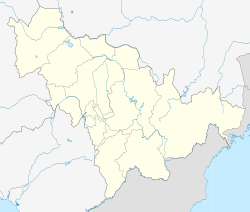Hwando
UNESCO World Heritage Site in Jilin, China From Wikipedia, the free encyclopedia
Hwando (Chinese: 丸都; pinyin: Wandu) is a mountain fortress of the ancient Korean[1] kingdom of Goguryeo, built to protect Goguryeo's second capital, Gungnae. It is located in present-day Ji'an city of the province of Jilin, China.
| UNESCO World Heritage Site | |||||||||
|---|---|---|---|---|---|---|---|---|---|
 | |||||||||
| Location | Jilin, China | ||||||||
| Part of | Capital Cities and Tombs of the Ancient Koguryo Kingdom | ||||||||
| Criteria | Cultural: (i)(ii)(iii)(iv)(v) | ||||||||
| Reference | 1135-003 | ||||||||
| Inscription | 2004 (28th Session) | ||||||||
| Area | 3,219.21 ha (7,954.8 acres) | ||||||||
| Coordinates | 41°9′51.2″N 126°6′55.9″E | ||||||||
| Chinese name | |||||||||
| Chinese | 尉那山城 | ||||||||
| |||||||||
| Korean name | |||||||||
| Hangul | 위나산성 | ||||||||
| Hanja | 尉那山城 | ||||||||
| |||||||||
The fortress is located 2.5 km west of Ji'an, Jilin province in Northeast China, near the North Korean border. It is part of the UNESCO World Heritage Site Capital Cities and Tombs of the Ancient Koguryo Kingdom, together with nearby Gungnae City and the Ohnyeosan City, because of its historical importance and exceptional architecture.[2]
History
In 3 CE, King Yuri of Goguryeo moved the capital to Gungnae Fortress, and built the Wina Rock fortress.[3] Gungnae Fortress, the capital, was a fortress on Amnok River's plain, while "Wina Rocks fortress" (위나암성; 尉那巖城) was a fortified city in the mountain which was later renamed to Hwando by King Sansang of Goguryeo.
Goguryeo consolidated its power and began to threaten the Chinese commanderies, under the nominal control of Wei. In 242, Dongcheon attacked a Chinese fortress near the mouth of the Amnok River leading to the Goguryeo–Wei War; in 244, Wei invaded Goguryeo and sacked Hwando.[4]
Goguryeo ended China's presence on the Korean peninsula by conquering the Lelang commandery in 313. However, Goguryeo faced opposition by the proto-Mongol Xianbei who had conquered northern China; the Murong clan of the Xianbei attacked Goguryeo and sacked Hwando in 341, capturing thousands of prisoners to provide cheap labor. The Xianbei also devastated Buyeo in 346, accelerating Buyeo migration to the Korean peninsula. Goguryeo, though temporarily weakened, would soon recoup and continue its expansion.[4]
Gallery
- Entrance plaque
- Detail of a wall
- Remains of a guard tower
- Goguryeo tombs near Hwando
References
Wikiwand in your browser!
Seamless Wikipedia browsing. On steroids.
Every time you click a link to Wikipedia, Wiktionary or Wikiquote in your browser's search results, it will show the modern Wikiwand interface.
Wikiwand extension is a five stars, simple, with minimum permission required to keep your browsing private, safe and transparent.






